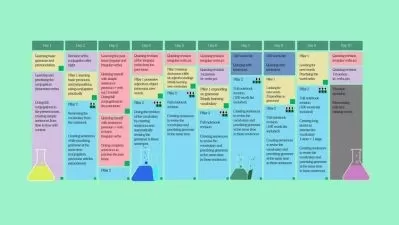Learning Spanish II: How to Understand and Speak a New Language
Bill Worden
22:07:01
Description
Learning Spanish II: How to Understand and Speak a New Language follows on The Great Courses’ highly acclaimed first Spanish course, taking you to the next level of mastery of this beautiful and incredibly useful language. This exciting program grounds you in the fundamentals that will help you work toward fluency, enhancing your ability to converse with your Spanish-speaking friends and acquaintances, to speak Spanish more skillfully as a traveler—to enjoy the thrill and pleasure of communication in a language spoken by half a billion people around the world.
As in our precursor course Learning Spanish, these lessons, taught by world-class language instructor Professor Bill Worden of The University of Alabama, present a cutting-edge language-learning system that has worked brilliantly for adult learners for over twenty years.
If you’ve completed our first level of Learning Spanish, or have the equivalent of a first-year Spanish course, these 30 lessons will give you the opportunity to practice what you know while advancing into new territory, which will prepare you for more advanced conversations and enhance your ability to express yourself in Spanish on a wide range of subject matter.
Professor Worden’s system makes learning Spanish both fun and wonderfully accessible, and this course is expertly organized to give you the elements of Spanish most vital to daily communication. Within each lesson, you’ll work with three fundamental learning “modules,” each of which builds facility with listening and speaking in Spanish:
- Grammar: First, you’ll continue to build the core elements of grammar—the “skeleton” of the language—giving you a solid foundation for using Spanish in many contexts. In each lesson, you’ll build facility with verbs, adding important verb tenses for expressing actions in the present, past, future, as well as the vital conditional tense. You'll also communicate using the imperative and subjunctive moods, which allow you to express commands, desires, feelings, and states of mind. Moreover, you’ll further your work with adjectives, adverbs, nouns, prepositions, pronouns, and their essential usage.
- Vocabulary: An ample vocabulary underlies real fluency, and here Professor Worden teaches you a rich and broad spectrum of words and expressions, reflecting those used most frequently in the Spanish language. Each lesson adds useful new vocabulary to your repertoire, and key lessons delve into specific vocabulary on subjects ranging from health and medicine to money, shopping, cooking, time, family, and more.
- Culture: Each lesson grounds you in a knowledge of the Spanish-speaking world, as it applies to using Spanish—the cultures, customs, and ways of thinking that surround the Spanish language. Here, you’ll learn how Spanish differs from English as a medium of expression, and you’ll delve into subjects such as the evolution of the Spanish language, the geography of the Spanish-speaking world, and iconic works of art and literature.
In addition to the core work of speaking and listening, the course gives you extensive practice in reading and writing through the course workbook, which allows you to interact with new vocabulary and grammar in their written forms. Learning Spanish II is designed as a natural progression that gives you the basis for real facility with the language as you work toward fluency in Spanish, enhanced by a host of onscreen diagrams and visual aids.
Build Solid Skills in Speaking and Listening
Becoming truly fluent in a language means moving beyond memorization. To speak a language well is to have the right words and expressions exactly when you need them—to always have them ready on the tip of your tongue. Learning Spanish II builds the resources you need to achieve this ease, in a way that is highly effective, and at the same time captivating and enjoyable. Professor Worden adds new grammar and vocabulary in digestible units, making each lesson fun and engrossing by changing subjects frequently and by relating the language itself to the cultures of the Spanish-speaking world.
Spanish verb forms can seem intimidating in their difference from the workings of English, but they are surprisingly easy to grasp once you understand how the basic structures of Spanish work. Throughout the course, you’ll work deeply with verbs, both regular and irregular. As a case in point, after the present tense (which you’ll practice extensively), the preterite tense (as in, “I walked” in English) and the imperfect tense (“I was walking” or “I used to walk”), are the most commonly used tenses in the Spanish language. You’ll encounter these tenses all the time, both when speaking and when reading and writing. In these lessons, you’ll work extensively with the preterite and the imperfect, learning how they function in Spanish, and exactly when to use each. Later in the course, you’ll add the present perfect tense (as in, “I have walked”), and the imperfect progressive construction, which describes ongoing past actions—leaving you with a rich range of ways to talk about past and present events, processes, and feelings.
In learning to express actions and thoughts, you’ll add the conditional tense (“I would like to travel”), the future tense (“Tomorrow we will leave”), the imperative mood, which expresses commands, and the present tense of the subjunctive mood, which is used in expressing desire, doubt, and emotion. Professor Worden’s finely honed teaching method makes this process into a fascinating and inspiring learning journey, as you see the structure of Spanish taking shape within your understanding.
Learn Verbal Tools for Everyday Communication
Speaking a language well also means being able to communicate about the practical details of everyday life. In these lessons, in addition to essential vocabulary, you’ll master grammatical resources for speaking about common, daily matters, including:
- Spanish prepositions (such as “underneath” and “behind” in English), and prepositional pronouns (as in “near them” or “next to him”)—vital for speaking about physical location;
- possessive adjectives (“my” or “your”) and possessive pronouns (“ours” or “theirs”) and other words that describe possession and relationship;
- reciprocal verbs (“We see each other every week”), which express actions done by people to each other;
- how to make comparisons between people and between things; and
- direct object pronouns (“I see them”), indirect object pronouns (“They write to her”), and double object pronouns (“He sends them to us”), indispensable for real world conversations.
With these and other grammatical tools, you’ll build the ability to speak not only about action, thought, and feeling, but about the features and details of daily living.
Accelerate and Maximize Your Learning Process
Perhaps equally as important as the material of the course, Professor Worden offers vital pointers—based on his decades of teaching—describing the most effective ways to study and learn a new language, and how to move forward as quickly as possible. Here, you’ll learn about:
- the nature of language acquisition and three fundamental qualities of successful language learners;
- key methods for expanding your vocabulary and a two-step system for making new words an active part of your speaking;
- how to develop the best mental attitude for language learning;
- practical ways to connect with Spanish speakers; and
- how to accelerate your learning by expanding your contact with the language.
Enjoy a New Level of Mastery in Spanish
In its design, Learning Spanish II offers you a wealth of resources for learning and practice. In addition to the 30 lessons themselves, each lesson includes a separate audio glossary, where you’ll hear a native speaker pronounce all of the new Spanish words you’ve learned, as well as review their meanings in English. The course workbook gives you essential practice in reading and writing, using your new grammar and vocabulary. And, the audio speaking activities that accompany each lesson allow you to further hone your listening and speaking skills, using dialogues in Spanish.
As another core aid to learning, Professor Worden gradually increases his use of Spanish in the lessons, eventually teaching the lessons in both Spanish and English. Throughout the course, you’ll work on Spanish pronunciation, highlighting sounds that don’t exist in English, as well as sounds that are analogous between the two languages, yet different. And, as an additional useful tool, you’ll learn a range of effective conversation openers, to engage immediately with the person you’re speaking to.
In exploring the rich cultures of the Spanish-speaking world, you’ll learn about how the language evolved from Latin, and the influences on it by German, Arabic, and Native American languages; and you’ll sample great art and literature, in the lives and works of such beloved figures as the novelists Miguel de Cervantes Saavedra and Gabriel García Márquez, and the great Renaissance painter El Greco.
Learning Spanish II: How to Understand and Speak a New Language takes you across an important and exciting threshold—from the beginning stages of communicating in Spanish to a more advanced level of speaking and understanding the language. Join a master language teacher in one of life’s great experiences—the never-ending adventure and discovery that speaking a new language brings.
More details
User Reviews
Rating
Bill Worden
Instructor's CoursesDr. Bill Worden is an Associate Professor of Spanish at The University of Alabama. He received his A.B. in Mathematics from Dartmouth College, his M.A. in Spanish from Middlebury College and his Ph.D. in Hispanic Studies from Brown University.
Since 2002, Dr. Worden has taught a wide variety of courses at The University of Alabama, ranging from Introductory Spanish and Advanced Grammar and Composition to undergraduate and graduate courses in 16th- and 17th-century Spanish literature.
Dr. Worden’s main area of research is the work of Miguel de Cervantes, especially his novel Don Quixote. Dr. Worden has published in the fields of early modern Spanish literature, colonial Cuban theater, and 19th-century Spanish literature. He has also published on pedagogical topics, including how to teach Spanish at the middle school and high school levels, and has lectured on approaches for helping beginning language students become comfortable speaking Spanish.
Dr. Worden was awarded the David and Ruth Kossoff Prize for Leadership in Language Teaching by the Department of Hispanic Studies at Brown University, as well as the Presidential Award for Excellence in Teaching by the Graduate School at Brown. In 2013, the Alabama Association of Foreign Language Teachers selected Dr. Worden as the winner of the annual Outstanding Foreign Language Teacher Award for Postsecondary.

The Great Courses
View courses The Great Courses- language english
- Training sessions 30
- duration 22:07:01
- English subtitles has
- Release Date 2023/06/06











